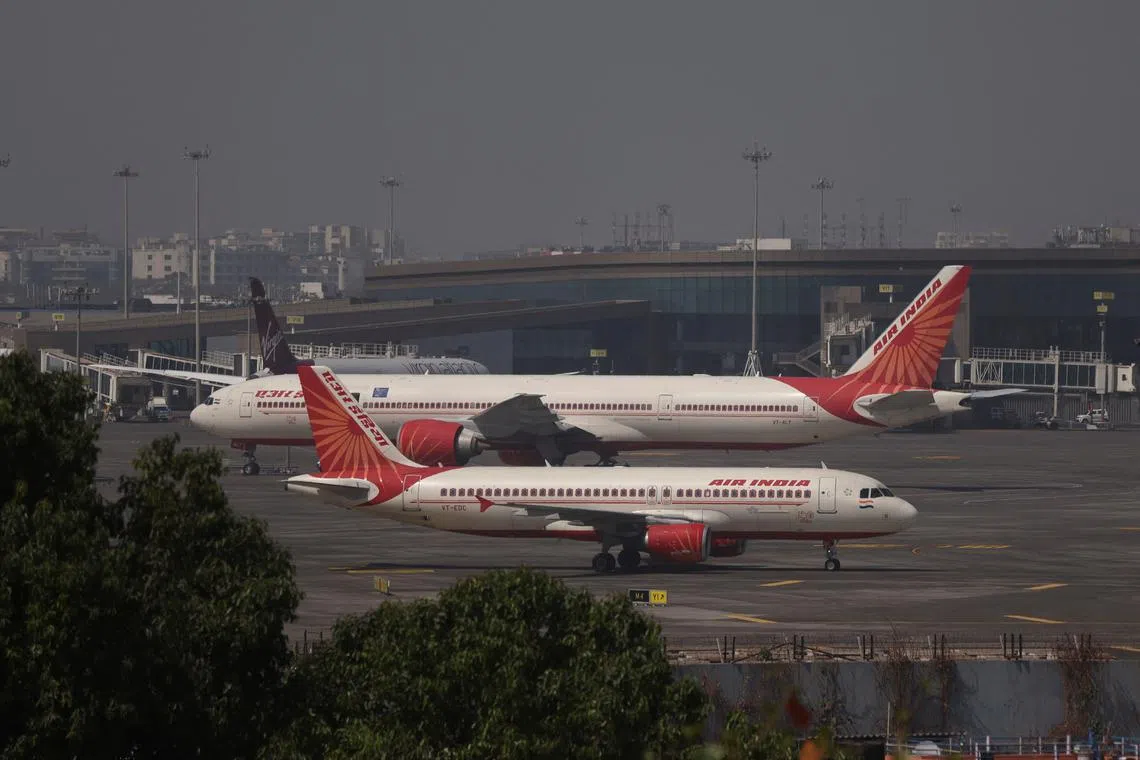Shortage of pilots could stall Indian aviation’s rise
Sign up now: Get insights on Asia's fast-moving developments

Airlines in India will need about 1,800 to 2,000 pilots and 4,000 to 5,000 cabin crew for new aircraft next year, said consulting group CAPA India.
PHOTO: REUTERS
Follow topic:
BENGALURU - As Indian aviation prepares for strong growth from 2024, a shortage of technical manpower, especially pilots, may be the greatest strategic risk for the sector, said aviation consulting group Capa India.
At least 1,100 new planes are expected to enter the Indian market in the next decade. Air India has ordered 470 new aircraft,
According to industry standards, each narrow-body plane requires 14 to 16 pilots, while a wide-body plane doing long-haul routes needs 24 to 26 pilots.
India has about 9,000 pilots for 700 aircraft. Capa India suggests airlines in India will deploy 150 to 175 new aircraft in 2024 and need about 1,800 to 2,000 pilots and 4,000 to 5,000 cabin crew for them.
Mr Amit Thakran, associate practice lead of Capa India, said that the shortage of skilled air and ground staff existed before Covid-19, but with the rapid recovery in air traffic after the pandemic, “this shortage is becoming more apparent and visible”.
Experts say that the historical backlog and inadequate flight-training facilities in India might hinder the growth of skilled aviation manpower.
“New hiring, especially for technical resources such as pilots, engineers, security staff and air traffic controllers, can take up to 18 months,” said Mr Thakran.
The Ministry of Aviation has maintained that India does not have a pilot shortage. In an interview with Indian newspaper The Hindu, then licensing authority Directorate General of Civil Aviation’s director general Arun Kumar, who retired on Feb 28, said there was “in fact an excess supply” of pilots. He dismissed concerns of an acute shortage of pilots in India, pointing to the record number of 1,200 commercial pilot licences (CPLs) issued in 2022.
While Mr Kumar said there was no dearth of pilots for narrow-body aircraft such as Airbus A320s and wide-body planes such as Boeing 777s, he admitted that “we do face issues with smaller aircraft”. Moreover, expanding airlines like Air India will need to induct as many as “7,000 to 8,000” pilots, he said.
A senior pilot, who requested anonymity, explained that a shortage and oversupply of pilots coexisted in India, because “thousands of CPL holders are still unemployed”, waiting to qualify as a co-pilot. A CPL holder needs to train for another 250 hours in simulators and training aircraft to be certified to fly.
The senior pilot said the shortage of training infrastructure was Indian aviation’s real bottleneck. There are 34 flying schools in the country, but there is a “desperate shortage of slots for simulators and fully qualified instructors”.
To fill the existing gap, airlines and flying schools have been temporarily employing expatriate pilots, paying them higher salaries, and sending trainees abroad for simulator training at a high cost, or asking the trainees to get certified abroad themselves.
The senior pilot said that “many young candidates are wondering if it’s worth spending almost 10 million rupees (S$162,500) in overall training for a monthly salary of around 100,000 rupees”.
Indian airlines are today offering better remuneration, but they face competition from foreign airlines that offer quick training, better pay and perks.
The record number of CPLs granted in 2022 only reflects the backlog from the pandemic, said the chief executive officer of Asia Pacific Flight Training Academy, Mr Hemanth DP. Pre-pandemic, only an average of 500-600 licences were issued a year.
“To fly the 1,100 new planes, India will need about 16,000 to 17,000 trained pilots, which is 1,500 a year on average. This is only for commercial airlines. Pilot requirements for general aviation and flight training are rapidly expanding too. At our average of 800 a year, we will only produce 8,000 pilots in the next decade. That’s not enough,” Mr Hemanth said. General aviation includes private jets, sightseeing planes, as well as planes for medical transport or agricultural purposes.
Currently, Air India and its subsidiaries have around 3,000 pilots to operate the combined fleet of 220 aircraft.
On Feb 23, the company announced that it would hire over 4,200 cabin crew trainees and over 900 pilots in 2023.
In a press conference on Feb 28, Air India CEO Campbell Wilson said: “We are going to be investing in a significant talent training academy to grow pilots locally, grow cabin crew, engineers and other professionals.”
Capa’s Mr Thakran said that a shortage of skilled manpower in aviation would lead to slower growth, higher expenses from parked planes, and higher manpower costs from increased salaries and training funds.
The fatigue and stress among existing over-worked employees is also a worrying prospect for an industry that places a premium on safety.
Additional reporting by Nirmala Ganapathy


